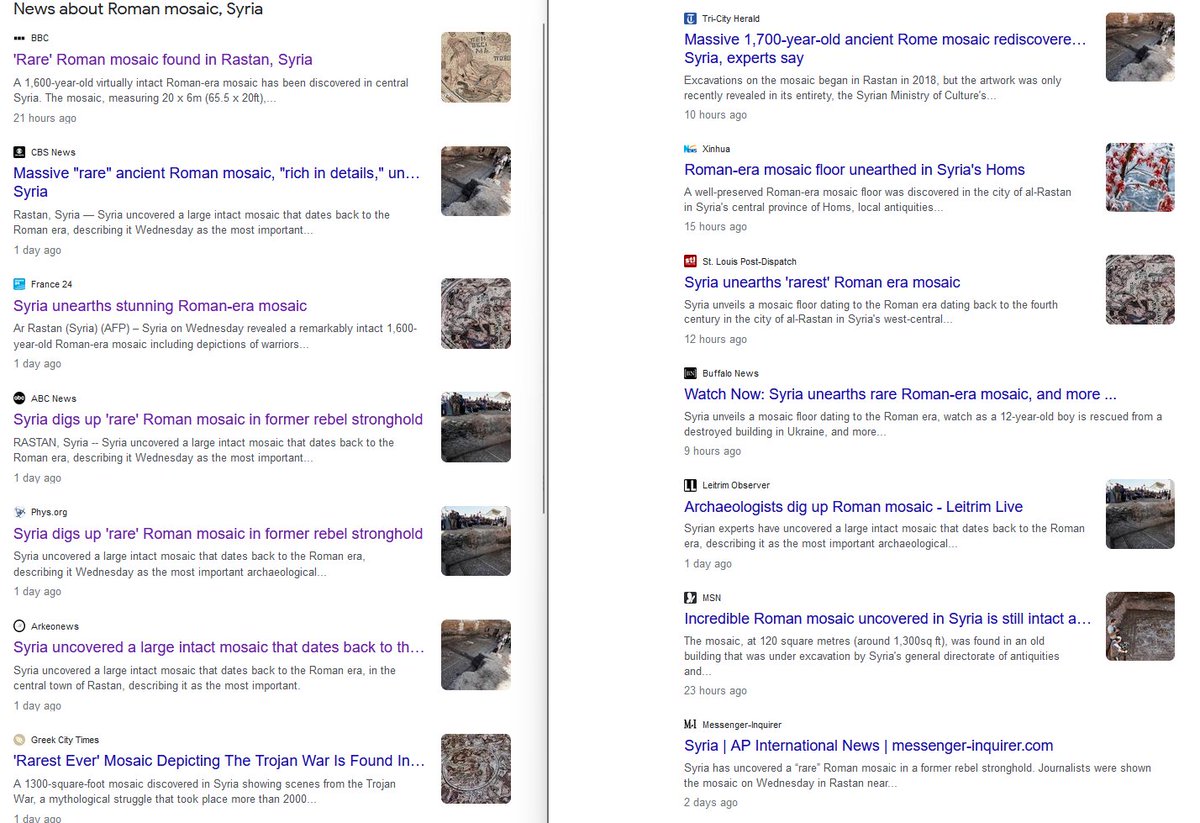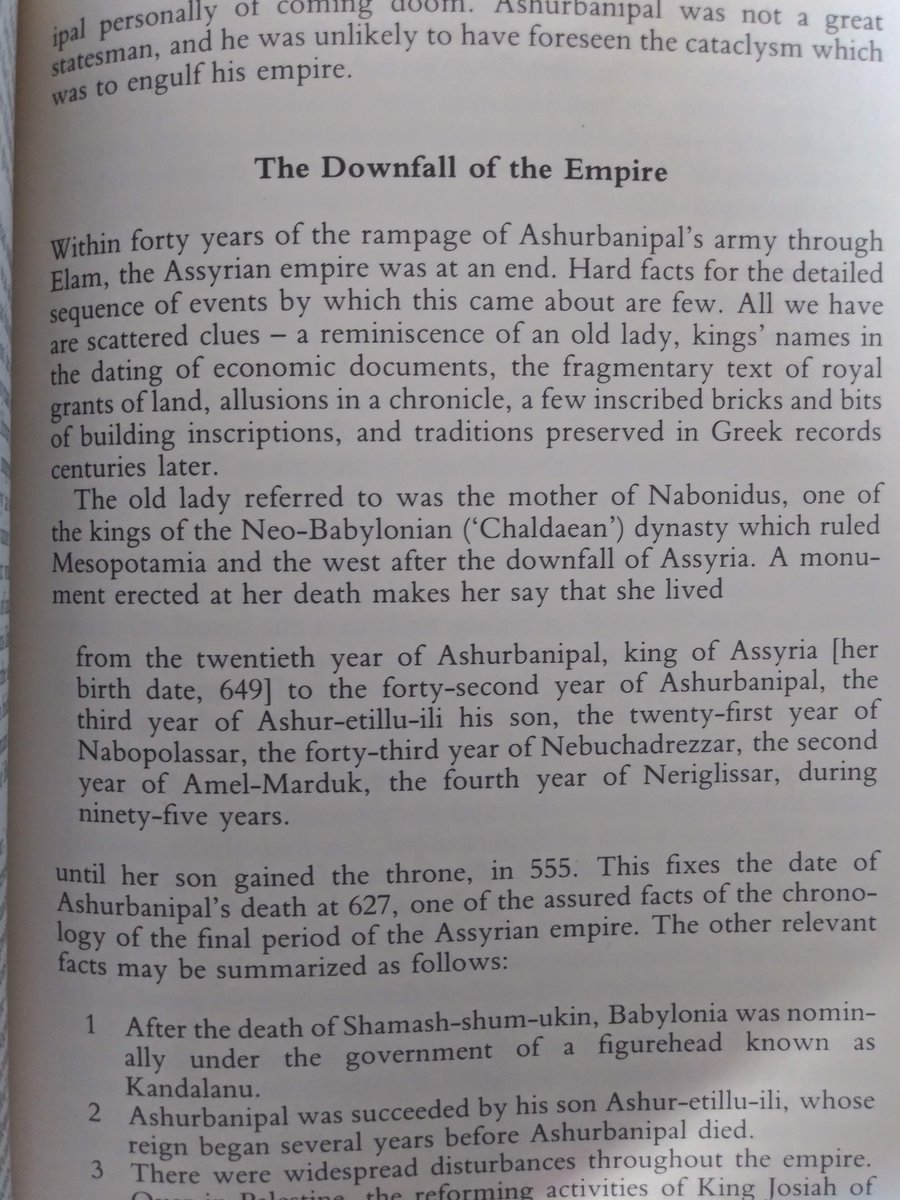
OK, I said yesterday that I'd take a brief dive into this this Syria mosaic. So here we go🧵:
First of all, a good rule of thumb is that when you see something blow up in the news like this, it's usually the result of a coordinated media campaign operating behind the scenes.
First of all, a good rule of thumb is that when you see something blow up in the news like this, it's usually the result of a coordinated media campaign operating behind the scenes.

That can be good! Public communication about our field is vital!
But no one takes the time to coordinate a media campaign for no reason. They do it because they want to shape public discourse in some way.
But no one takes the time to coordinate a media campaign for no reason. They do it because they want to shape public discourse in some way.
Sometimes the reason is "hey archaeology is awesome people should be interested in it." But often it's more than that.
Most of the stories are based on a report by AP journalist Albert Aji. The AFP appears to have also filed a story.
apnews.com/article/scienc…
Most of the stories are based on a report by AP journalist Albert Aji. The AFP appears to have also filed a story.
apnews.com/article/scienc…
To be clear Aji is a solid, legitimate journalist, this thread is not an attack on him at all. His reporting on this find is excellent.
The mosaic is also an incredible find. It's very large, containing scenes and characters from the Trojan War:
The mosaic is also an incredible find. It's very large, containing scenes and characters from the Trojan War:

But some things jumped out at me while reading the AP report.
First, the Syrian government organized a tour for journalists at the site. This shows the government wants to publicize the find and wants to generate articles about it in foreign media.
First, the Syrian government organized a tour for journalists at the site. This shows the government wants to publicize the find and wants to generate articles about it in foreign media.
Second, the tour was given by Dr. Humam Saad, associate director of excavations at DGAM and Sulaf Fawakherji, a famous actress in Syria.
(pic from the Arabic page of SANA, no other articles have pics of the presenters: sana.sy/?p=1760353)
(pic from the Arabic page of SANA, no other articles have pics of the presenters: sana.sy/?p=1760353)

Why is an actress giving a tour of a dig site? Well, Ms. Fawakherji does have a university degree in archaeology. She's also a vocal supporter of Bashar al-Assad.
But more importantly she's on the board of trustees of the Nabu Museum in Lebanon.
But more importantly she's on the board of trustees of the Nabu Museum in Lebanon.
The Nabu Museum is a project of Lebanese businessman Jawad Adra which opened in 2018. It contains artifacts from all across the Middle East, all of them purchased on the private market. 

The Nabu museum has come under scrutiny as suspicions have been raised that many of its artifacts were looted from conflict zones: libnanews.com/en/the-former-…
But wait, you say, is private collecting even legal in Lebanon? It wasn't until December 2016, when Culture Minister Raymond Arayji issued Decree 3065, legalizing private antiquities collecting in Lebanon so long as the contents of the collections were reported to the government.
Suspicions have been raised that this law was changed specifically to benefit Adra and the Nabu Museum.
Arayji is a member of Michel Aoun's Free Patriotic Movement, and issued this decree less than two months after Aoun was inaugurated as President of Lebanon.
Arayji is a member of Michel Aoun's Free Patriotic Movement, and issued this decree less than two months after Aoun was inaugurated as President of Lebanon.
Aoun also appointed Adra's wife Zeina Akar (also a FPM member) as Defense Minister in 2020 despite her having no background in national security. She went on to become Foreign Minister and Deputy Prime Minister, until resigning in September 2021 after the Beirut port explosion.
But Adra isn't the only politically connected collector in Lebanon. Anti-Syrian MP Nohad Machnouk made waves a few years ago when he gave an interview on TV with artifacts from Palmyra in his office: english.enabbaladi.net/archives/2021/… 

So why did Adra want to found a museum of Middle Eastern antiquities?
Adra is a longtime member of the Syrian Social Nationalist Party, a political party founded by the Lebanese journalist and political thinker Antun Sa'adeh in 1932.
Adra is a longtime member of the Syrian Social Nationalist Party, a political party founded by the Lebanese journalist and political thinker Antun Sa'adeh in 1932.
Sa'adeh believed that things like religion and language were relatively unimportant in forming group identities. What really mattered was geography, which controlled what type of common life was possible.
He therefore argued that the Middle East was really one nation which had been divided by colonialism, and that Iraq, Syria, Lebanon, Jordan and Palestine should merge into one country called "Greater Syria."
The boundaries come pretty close to the borders of the Assyrian Empire.
The boundaries come pretty close to the borders of the Assyrian Empire.

Sa'adeh was executed for trying to overthrow the government of Lebanon in 1949 and merge the country with Syria. The SSNP has survived in both Lebanon and Syria.
In Lebanon the SSNP has been pro-Syrian throughout the Syrian occupation from 1976-2005.
In Lebanon the SSNP has been pro-Syrian throughout the Syrian occupation from 1976-2005.
In Syria, the party has been closely aligned with the Assad family, with the Assads drawing on "Greater Syria" ideology whenever necessary.
Hafez al-Assad's wife Anissa Makhlouf came from an SSNP-supporting family.
SSNP militia fight on Assad's side in the Syrian Civil War.
Hafez al-Assad's wife Anissa Makhlouf came from an SSNP-supporting family.
SSNP militia fight on Assad's side in the Syrian Civil War.
The purpose of the Nabu Museum is to promote a Greater Syria identity in the Middle East, as part of a weird political party allied with the Assad family.
Turns out, the Nabu Museum bought the land on which this mosaic was discovered, then donated it to the Syrian government.
Turns out, the Nabu Museum bought the land on which this mosaic was discovered, then donated it to the Syrian government.
Fawakherji says that she hopes the museum will purchase additional buildings in Al-Rastan so they can excavate more.
Why does the Nabu Museum need to buy land in a country where all antiquities are state property? 🤷♂️
Why does the Nabu Museum need to buy land in a country where all antiquities are state property? 🤷♂️
Dr. Saad adds that the mosaic's location has been known since 2017, because a rebel group tried to sell in on social media.
Rastan was captured by rebels in 2012, and not retaken by the Assad government until 2018.
Rastan was captured by rebels in 2012, and not retaken by the Assad government until 2018.
So to recap we have:
1) Syrian rebel group finds mosaic while digging, tries to sell it to fund operations.
2) Assad government retakes city.
3) Individuals associated with the SSNP buy the building where the mosaic was found, give it to gov who already owns the mosaic inside.
1) Syrian rebel group finds mosaic while digging, tries to sell it to fund operations.
2) Assad government retakes city.
3) Individuals associated with the SSNP buy the building where the mosaic was found, give it to gov who already owns the mosaic inside.
4) Government excavates, apparently in close cooperation with SSNP-linked individuals who work to publicize finds in western media.
I have written before about how the Assad government is using archaeology in an attempt to launder its international reputation.
I have written before about how the Assad government is using archaeology in an attempt to launder its international reputation.
The strategy is to present Assad's government as the 'defenders of civilization' and protectors of 'universal heritage.'
Artifacts from the Roman Empire with clear cultural connections to the West are especially useful for this purpose.
Artifacts from the Roman Empire with clear cultural connections to the West are especially useful for this purpose.
For more on Assad's political use of archaeology, see my article here: academia.edu/37012033/Under…
Nelly Abboud also has an excellent article on the Nabu Museum here: academia.edu/45566964/The_N…
Nelly Abboud also has an excellent article on the Nabu Museum here: academia.edu/45566964/The_N…
• • •
Missing some Tweet in this thread? You can try to
force a refresh













